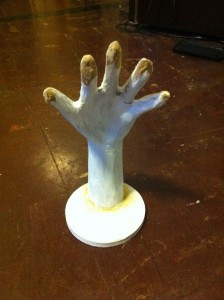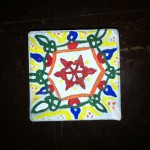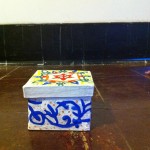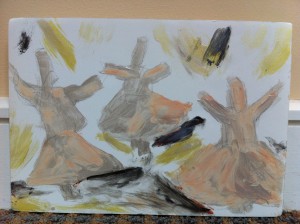Introduction: Who’s Islam? Whose Islam?
I still call myself a communist, because communism is no more what Russia made of it than Christianity is what the churches make of it.”
–Pete Seeger
When I enrolled in this course, the international airwaves were dominated by the latest violence and upheaval associated with the year-old Arab Spring. Civil and political unrest, beginning in Tunisia, had spread like wildfire through parts of the Middle East and North Africa. One after the other, heads of state stepped down or fled, in many cases ending decades-long rule. Frustrated adolescents took to the streets, buttressed by social media platforms like Twitter. The first six months of 2011 saw the successive ouster of Zine el-Abidine Ben Ali in Tunisia, Hosni Mubarak in Egypt, Ali Abdullah Saleh in Yemen, and Muammar Gaddafi in Libya. Indeed, the Middle East had reached a boiling point, but I remained largely ignorant of the religious and historical underpinnings of these populist uprisings. After years of sectarian violence, it seemed like the Islamic world had finally declared total war on itself.
Yet Professor Asani suggested from the first lecture that perhaps this conflict was not tied to religion itself. He said, “Religion does not have agency. People have agency. People use their own interpretation of religion for their own ends.” It had always seemed to me that people committed acts of incredible charity, selflessness, and violence because that was what their religion dictated. Homosexuality, adultery, and murder were sinful because the Bible said so. Religion dictated what was right and wrong, and people acted accordingly—not the other way around. (For more on the power dynamics and politics of religion, see Creative Response: Power, Islam, and The Beggar’s Strike.)
I had long been taught that Islamic fundamentalism and Al-Qaeda were fundamentally at odds with the tenets of Islam. Islam was a “peace-loving religion” and the Qur’an preached a message of peace. These fundamentalists were outliers and did not speak for the religion itself. They were acting in the name of jihad and Islam, but what they were practicing was not Islam at all. When the United States went to war in Afghanistan, it was not an assault against Islam, but rather, an effort to stamp out the Taliban, a dangerous and violent fringe group. Unfortunately, the moderate Muslim mainstream was caught in the crossfire.
This course challenged my longstanding belief that there is an identifiable and definable Muslim mainstream. From Sufi shrines in South Asia to international Qur’an-reciting contests, Islamic practice is as broad and diverse as its followers. Some Muslim men wear beards to emulate Mohammad, while others scoff at the idea that physically impersonating the prophet has any spiritual value. In parts of Saudi Arabia, music and dance is scorned, whereas for many Sufis, music, dance, and poetry are fundamental parts of spiritual identity. In some predominantly Muslim countries, hijab is mandatory for women, and in other places, it is completely absent (see Creative Response: Women and Islam, Sultana’s Nightmare). In particular, studying Sufi mysticism, which is deeply connected to local culture in North Africa and South Asia, taught me that my understanding of Islam was based on an Arab-centric model.
At the most basic level, this course stretched the bounds of what I thought it meant to be Muslim. And by learning about Islam through the lens of the arts, I started to see the astounding diversity of Islamic religious expression. The texts ran the gamut: we examined early feminist utopian short stories (Sultana’s Dream), love poems, calligraphy, Persian dramatic plays, architecture, whirling dervishes, Muslim rock music, political posters, and memoirs about growing up in Iran and navigating American Muslim identity.
I had always believed that Islam had a basic paradigm (the one that is practiced in the Arab Middle East). Deviations from this mold were due to exterior political and cultural contexts, like Bengali Muslims who have incorporated Hindu prophets and rituals into their spiritual practice. (Many Bengali Muslims believe in the Ten Avataras of Vishnu and consider Rama and Krishna to be prophets. Mohammad is considered the last in this line of prophets. In Southern Pakistan, largely a Shia community, the last avatar is Ali.) This concept of connecting and blending into the pre-existing culture and belief system is called religious indigenization.
But I soon learned that religious indigenization was not limited to North Africa, China, and South Asia—which I perceived to be offshoots of the traditional Arab model. The Arab model, too, was deeply influenced and shaped by cultural and political context. For instance, the Hajj is based on a pre-Islamic ritual, and people had long been making pilgrimages to this spot for idol worship. Muslims redefined the purpose of the pilgrimage to connect with Abraham, Mohammad, and God. Indeed, a political context of violence and tribal warfare had tremendous influence on Islamic practice. As we saw in “The Miracle Play of Hasan and Husein,” the tensions between Sunnis and Shia date to familial and clan conflict. Shia Muslims, in particular, emphasize the importance of suffering for spiritual redemption, an idea rooted in the collective memory of the brutal killing of Husein and his followers (see Creative Response: Hand of Fatima).
The Qu’ran gives few specific prescriptions about how religious piety should be practiced and expressed. The prescriptions are vague, conflicting, and open for broad interpretation. The hadiths, which recall Mohammad’s words and actions, have more nuanced advice, and are used to supplement the Qu’ran. But the hadiths, too, conflict and their reliability are disputed, as they are not the direct word of God and have been distilled through word of mouth. As a result, even the most basic ritual practices are open for broad interpretation.
Practices as seemingly fundamental and intransient as the Five Pillars are actually influenced by historical and political context. For Sunnis, the Five Pillars of Islam are the five fundamental practices of religious identity (orthopraxy). Yet there is no mention of the Five Pillars in the Qu’ran. The Qu’ran only mentions individual acts of prayer, Hajj, fasting, etc., but does not lump them together or call them the central pillars of religious expression. Instead, the Five Pillars are part of the hadiths. There are some hadiths that mention three, six, or other numbers of pillars, and sometimes include practices like caring for your parents.
In fact, the Five Pillars at the center of Sunni religious expression were established more than 300 years after Mohammad’s death. They were widely promoted by a Sunni Caliphate that was trying to consolidate power. (Shia Muslims do not give as much credence to the Five Pillars, and some have offered a sixth pillar for jihad.) Indeed, the emergence of the Five Pillars was tied to politics of the time. Ritual practice is a vehicle for differentiating and distinguishing yourself from the masses. It is a way of asserting and holding onto your cultural and religious identity when it is in jeopardy. Professor Asani suggested that the recent resurgence of the Five Pillars among Sunni Muslims is a response to the encroachment of westernization and secularization. It is a way of fending off these influences by uniting the community in their shared religious and cultural history. (For more on mediating the West and Islam, see Creative Response: Blue-Eyed Blues.)
The Qu’ran also has little to say on the subject of music and whether it is to be encouraged or forbidden. There are hadiths that say Mohammad himself listened—or didn’t object—to music. But many Muslims say that music promotes appreciation of created things for our own sake, rather than God’s sake. Music is satanic and possesses people like a drug or alcohol, removing their ability to distinguish between right and wrong. This transformative property brings the whole category of entertainment under suspicion, as people lose or forget themselves. For these critics, music is a force that is unruly and out of control.
Despite these criticisms, music and dance are at the heart of Sufism. Many Sufis believe that music is an avenue to God. For example, the famous Sufi whirling dervishes (see Creative Response: Whose Islam? Sufism and Religious Expression Through Music and Dance) are a reenactment of the process of remembering God through dance. Only those who have been sufficiently spiritually initiated participate in the dervishes. Participants wear a cloak of black material, and remove it as they begin to dance as a sign of spiritual rebirth. Casting off the black cloak is analogous to casting off the material world. The white shroud underneath symbolizes purity and starting anew. (In a similar vein, many Muslims are buried in a white shroud to connect with the heavens, where their soul originated.)
For Sufis, music can incite ecstasy for those who are sufficiently spiritually initiated. Rather than the content of the music itself, there are strict guidelines about the proper audience for music. Music is reserved for a spiritual elite. It is only for those who will not fall into the trap of seeing music as aesthetic and pleasurable entertainment. Qawwali, a form of Sufi music popular in South Asia, incorporates poetry and is usually sung in Urdu or Punjabi. Qawwali is traditionally performed at Sufi shrines, which have gained international regard as popular tourist destinations. The rhythm of the music is supposed to pulsate like a heart beat. With the heart and the music beating together, people forget themselves and their corporeal existence, and tune into their primordial state. Because everyone has a different pulse, musicians will change their rhythms to synchronize with various audience members. Audience members respond to different rhythms. This sense of losing yourself spontaneously, and not through prayer, highlights the tension between ritualized practice and spontaneous feeling.
Reciting the Qu’ran is not considered music, though it is an oral/aural text. It is the recitation of the word of the divine. Qu’ran recitation is above any kind of human creation, like music or art. It is in another spiritual plane, incalculably more divine, beautiful, and prophetic. Unlike the spontaneous creation of music, reciting the Qu’ran is a disciplined form of religious expression with strict instructions. Tajweed, or the Qu’ran’s rules of elocution, are incredibly complex and only the most schooled and disciplined can master them. For example, there are complex rules about where to place the tongue in relation to the teeth for a particular sound, how to pronounce individual letters, how to pronounce a combination of letters, how long a sound should be, and the like. Rather than something novel, the Qu’ran is recited so many times that it becomes a part of you. Music, in contrast, can be improvisational, evoking a different kind of spiritual state. Much of the criticism of qawwali and music centers on its hypocrisies: it is billed as being only for certain cultivated people, but its broad audiences at Sufi shrines surely include those who are not spiritually initiated. Moreover, qawwali has been used in missionary work in South Asia, and surely those who have yet to convert to Islam are not spiritually initiated.
Islam teaches that God is known through experience. Many Muslims adhere to certain physical regiments that they believe will help them achieve analogous spiritual states. For instance, prostration during prayer is a physical act of submission before God. This physical act is supposed to facilitate spiritual submission before God, which requires moving from an ego-centric framework to a God-centric framework. Similarly, Mohammad and his followers were said to have all wept while reciting the Qu’ran, overwhelmed by God’s presence. They wept for the simultaneous presence and absence of God, who is everywhere and yet cannot be fully understood. For Muslims, connecting with God is an act of remembrance (dhikr). Humans have forgotten what it feels like to be connected to God, so they must take actions to reacquaint themselves with God’s presence.
These practices are examples of the liminal state, a transition into another mode of being that is detached from everyday life. In liminal rituals, people remove themselves from their general (usually secular) activities to carve out a space for reflection, where they are transformed and then return to daily life. Salat (or prayer five times a day) is an example of the liminal state, as it is a space for reflection, meditation, and remembrance of God. Hajj is also example of the liminal state, as people leave their homes, men dress in special white garments, and people physically connect with the story of Abraham and Mohammad. Hajj requires people to completely abandon daily life for an extended period. When people return from the pilgrimage, they are sometimes transformed and have a new outlook on life and religion. Malcolm X famously took a pilgrimage to Mecca, where he interacted with Muslims of all races. The experience led him to recant some of his more polarizing views about black nationalism.
Islam’s diversity of religious expression is made clear by the numerous debates surrounding the acceptability of fine arts, music, dance, and the role of women. But I (and many other Westerners) failed to see the nuances of these debates, and instead believed all Muslims adhered to a narrow paradigm of religious expression. (This oversimplification of Islam by Westerners is particularly striking in Islamic art criticism, see Creative Response: Mediations on the Arabesque).
As sectarian violence continues to wreak havoc in many Muslim countries, there is the constant question of “Whose Islam”? Should sheiks, ayatollahs, and other religious leaders also have political authority? Is separation of religion and state tenable in predominantly Muslim countries? The question of “Whose Islam” has been hotly debated since Mohammad’s death. But this question is not to be found in the Qu’ran. Even the shahadah, the Muslim declaration of faith, is found in the hadiths. With little guidance from the Qu’ran, the question of “Who’s Islam” and what it means to be a Muslim becomes a cultural and political question. It is also a deeply individual question, one that can be challenged and mulled over, as we see in Michael Knight’s tumultuous spiritual journey. This course demonstrated the flexibility of interpretation that Islam allows, and its incredible malleability to local customs and cultures. Pigeon-holing Muslim identity, as I did, effectively creates an us versus them mentality. In discovering the flexibility and diversity of Muslim identity and practice, I learned to see the rigidity of my own stereotypes. Perhaps it is those of us in the secular West who need to loosen up our thinking and let go of our skepticism about spirituality and religious practice.
Permalink Comments off





















